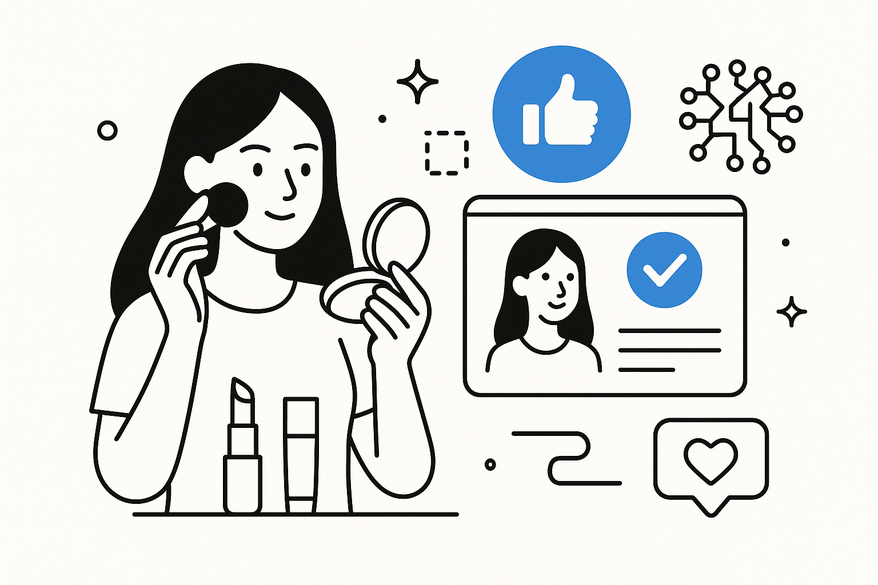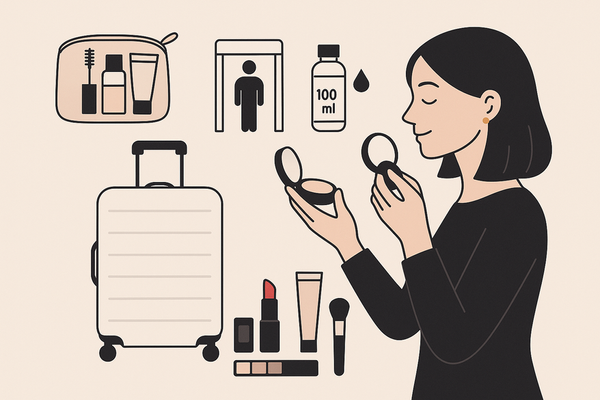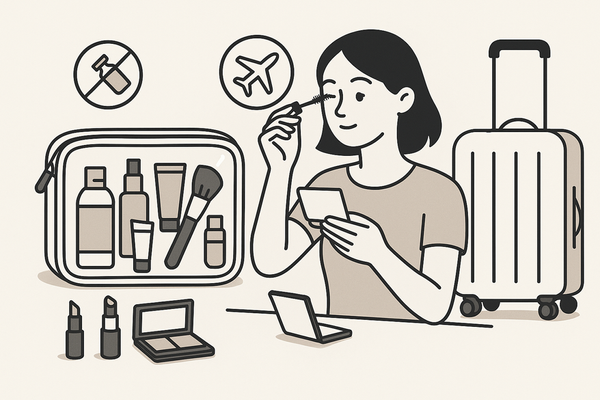Mastering Makeup Check AI Social Sharing Strategies for Maximum Engagement
Discover how makeup check AI social sharing strategies boost beauty brands' engagement with AI-powered insights and social media tactics.

Estimated reading time: 10 minutes
Key Takeaways
- AI-powered makeup checks automate quality control and offer real-time tips.
- Strategic social sharing amplifies reach, engagement, and brand loyalty.
- AR and virtual try-ons boost conversion rates and encourage user-generated content.
- Data-driven optimization refines content formats, timing, and audience targeting.
Table of Contents
- Section 1: Understanding the Basics of Makeup, Check, AI, Social Sharing, Strategies
- Section 2: The Role of AI in Social Sharing Strategies for Makeup Check
- Section 3: Makeup Industry Specifics for Social Sharing, AI, Strategies, Check
- Section 4: Developing a Comprehensive Social Sharing Strategy with AI, Makeup, Check
- Section 5: Best Practices and Tips for Strategies, Social Sharing, AI, Makeup, Check
- Section 6: Measuring Success and Continuous Improvement with AI, Social Sharing, Strategies, Makeup, Check
- Conclusion
For seamless AI-powered makeup analysis and optimization, beauty professionals and enthusiasts can try Makeup Check AI, which streamlines shade matching and trend insights in one intuitive platform.
Section 1: Understanding the Basics of Makeup, Check, AI, Social Sharing, Strategies
In this section, we break down key terms. Each word plays a role in a smart plan.
Definitions
- Makeup: Cosmetic products used to enhance facial features and personal appearance.
- Check: Evaluating or verifying the quality, trend alignment, and application of makeup—often aided by technology.
- AI (Artificial Intelligence): Machine systems that mimic human intelligence, used here for makeup analysis, trend prediction, and consumer engagement.
- Social Sharing: Distributing content—photos, videos, or tutorials—across platforms like Instagram, TikTok, and YouTube to drive engagement.
- Strategies: Planned approaches to maximize content visibility, reach, and engagement.
How They Work Together
- AI Automates Quality Checks
– Scans images for color accuracy and blending errors.
– Suggests product tweaks or application tips.
Source: makeup-check AI influencer case studies - Social Sharing at Scale
– Pushes share-worthy photos and videos to multiple networks.
– Uses scheduling tools to hit best posting times.
– Engages fans with one click. - Strategies Orchestrate Insights
– Combine AI data and sharing tools into a calendar.
– Set goals: shares, likes, conversions.
– Adjust plan with real-time reports.
Why It Matters
Integrating AI is now critical: it provides real-time insights, trend spotting, and tailored recommendations that manual methods can’t match. Generative AI is driving new possibilities in the beauty industry, from fresh looks to fast feedback.
Sources:
beauty brands using AI
generative AI in beauty industry
Section 2: The Role of AI in Social Sharing Strategies for Makeup Check
AI supercharges social sharing strategies. It finds trends, powers tools, and tunes campaigns.
Trend & Behavior Analysis
- AI Scans Platforms
– Tracks hashtags, captions, and emojis.
– Monitors sentiment: love, wow, meh.
– Alerts brands to rising themes, like “glossy lip” before it peaks. - Real-World Example
– A brand spotted “matte blush” surging on TikTok and launched a reel series in 24 hours, hitting 100K views.
Source: beauty brands using AI
AI-Powered Toolkits
- Makeup Check AI
– Analyzes user-generated makeup images in real time.
– Recommends color blends, techniques, and product matches.
– Works via mobile app or web plugin.
Source: makeup-check AI influencer case studies - Perfect Corp’s Virtual Try-Ons
– Uses AR to overlay products on live video.
– Suggests shades and textures tailored to each face.
– Increases trial-to-purchase rates.
Source: generative AI in beauty industry
Optimization & Targeting
- Content Formats
– AI picks between Reels, IG Stories, or static posts.
– Tests which style gets more shares. - Best Posting Times
– Finds local high-engagement windows (e.g., Thursdays at 5 PM).
– Auto-schedules posts for top slots. - Demographic Segments
– Spots age, gender, and interest clusters.
– Delivers ads and posts to the right group.
Source: AI-powered virtual makeup try-ons
Section 3: Makeup Industry Specifics for Social Sharing, AI, Strategies, Check
The makeup world has a strong visual and social DNA. AI tools fine-tune every step.
Visual Authenticity
- Demand for Real, High-Quality Visuals
– Shoppers trust clear images over stock photos.
– AI adjusts lighting and color to match real-life results.
– Ensures product shots match how makeup looks in person.
Source: makeup-check AI influencer case studies
Experimentation & AR Try-Ons
- Virtual Try-On Tools
– Let users test looks digitally.
– Boost trial conversions by 70%.
– Encourage shares of “before & after” looks.
Source: AI-powered virtual makeup try-ons - AR Filters in Stories
– Break-through filters that swirl blush or change lipstick shade.
– Sparks UGC when people post their try-ons.
Community-Driven Trends
- Grassroots Transformations
– Fans post unique looks and tag brands.
Learn more at user-shared makeup transformations - Informing Product Development
– Brands use AI analytics to choose next-season shades.
– Cuts R&D time by 30%.
Source: user-shared makeup transformations
AI Analytics for Brand Strategy
- Micro-Trend Identification
– Finds niche looks (e.g., pastel eyeliner) early.
– Informs small-batch launches. - Key Influencer Spotting
– Ranks creators by engagement, not just follower count.
– Pairs brands with the right micro-influencers. - Real-Time Feedback Loops
– Brands react fast to mood shifts (bright neon vs. soft nude).
– Keeps campaigns fresh and on-trend.
Source: beauty brands using AI
Section 4: Developing a Comprehensive Social Sharing Strategy with AI, Makeup, Check
Creating a plan step by step.
Step 1: Research & Analysis
- Use AI Platforms
– Makeup Check AI for image analysis.
– Social listening tools like Brandwatch. - Map Competitor Activity
– Track their top posts and hashtags.
– Note their posting schedule. - Detect Trends
– Spot rising makeup looks.
– Measure audience engagement metrics.
Source: makeup-check AI influencer case studies
Step 2: Content Planning
- Monthly Calendar
– Schedule tutorials, product demos, and influencer takeovers.
– Assign themes: “Bold Brows Week,” “Glowy Skin Month.” - AI-Driven Theme Selection
– Use data to pick topics with high share potential.
– Choose formats: TikTok challenges, IG Live, carousel posts.
Sources:
user-shared makeup transformations
generative AI in beauty industry
Step 3: Scheduling & Automation
- Automated Posting
– Tools like Hootsuite’s AI assistant post at peak times.
– Syncs with multiple platforms. - Auto-Responses
– AI chatbots reply to comments and DMs.
– Answer FAQs about shades and products instantly. - Real-Time KPI Tracking
– Dashboard shows reach, likes, shares, and conversions.
– Adjust campaigns on the fly.
Source: beauty brands using AI
Section 5: Best Practices and Tips for Strategies, Social Sharing, AI, Makeup, Check
Key tips to get the most from your strategy.
Clarity & Authenticity First
- Use Clear Step-by-Step Visuals
– Show each stage of application.
– Before-and-after shots build trust.
Source: user-shared makeup transformations - Genuine Storytelling
– Share brand origin and creator journeys.
– Let fans see real results.
Leverage Platform Features
- AR Filters & Virtual Try-Ons
– Instagram face filters or Snapchat AR.
– Boost engagement by 30%.
Deep dive at master social media makeup tips - Interactive Polls & Quizzes
– Ask fans to vote on next shade.
– Gather insights while increasing shares. - Reels & TikTok Effects
– Use trending transitions and music.
– Add branded stickers and hashtags.
Continuous Monitoring
- Analytics Dashboards
– Check reach, engagement rate, and share growth weekly.
– Compare content types (video vs. still). - AI Feedback
– Let AI recommend schedule tweaks.
– Identify underperformers fast.
Case Studies
- Lookfantastic
– AI-powered campaign optimization led to a 25% engagement uplift.
– Highlighted top micro-influencers and trending looks early.
Source: makeup-check AI influencer case studies - L’Oréal’s Modiface
– AR and AI integration yielded a 21% rise in conversion rates.
– Personalized virtual try-ons drove more purchases.
Source: generative AI in beauty industry
Section 6: Measuring Success and Continuous Improvement with AI, Social Sharing, Strategies, Makeup, Check
Track and refine your plan.
Define KPIs
- Engagement Rate
– Likes, comments, and shares divided by total reach. - Follower Growth
– Net new followers per week or month. - Share Count
– Number of times posts are reshared. - Virality Coefficient
– Average shares per view. - Conversion Rate per Post
– Clicks to product pages divided by total clicks.
AI-Generated Reports
- Performance Summaries
– Dashboards highlight top content and weak spots. - Automated Insights
– AI suggests content boosters or cuts low-performers.
Sources:
makeup-check AI influencer case studies
generative AI in beauty industry
Iterative Refinement
- Monthly Reviews
– Meet with your team to discuss AI insights.
– Update content themes and posting cadence. - Stay Ahead of Platforms
– Watch for new features (e.g., Instagram Notes).
– Adapt before competitors.
Source: beauty brands using AI
Conclusion
Makeup check AI social sharing strategies empower beauty brands to revolutionize social media marketing through real-time analysis, smart optimization, and authentic engagement. By using AI for makeup analysis, trend spotting, and targeted content, brands can deliver personalization, measure impact, and foster community growth.
Explore in-depth influencer case studies: makeup-check AI influencer case studies
Now it’s your turn. Implement these makeup check AI social sharing strategies to elevate your brand’s online presence. Share your questions, success stories, and tips below. Let’s grow together—spread the word and inspire others in the beauty community!
FAQ
What is AI-powered makeup check?
AI-powered makeup check uses machine learning to analyze makeup application, ensuring color accuracy and recommending improvements in real time.
How do AR try-ons improve conversion rates?
AR try-ons let users visualize products on their own faces, increasing confidence and resulting in up to 70% higher trial conversions.
What metrics should brands track for success?
Key metrics include engagement rate, follower growth, share count, virality coefficient, and conversion rate per post.
How can I start implementing these strategies?
Begin with AI-powered platforms like Makeup Check AI for research, build a content calendar, automate scheduling, and continually refine based on AI-generated insights.




